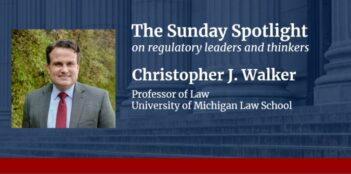
To be excellent, a regulator must select the correct virtues.
A regulator seeking to be “best in class” may, understandably, wish to maximize as many different operational, institutional, and interpersonal virtues as possible. But what if increasing one virtue inexorably decreases its opposite, when that opposite is also needed to be truly excellent? Should (and can) a regulator be both meticulous and nimble? Is it possible for a regulator to be both flexible and firm?
These are some of the questions asked by Adam Finkel in a chapter of the newly published book Achieving Regulatory Excellence. Finkel, a senior fellow at the Penn Program on Regulation and a former senior executive at the U.S. Occupational Safety and Health Administration (OSHA), argues that inherent tradeoffs in most well-accepted regulatory virtues mean that excellent regulators must succeed in exhibiting the correct—and correctly balanced—virtues.
Much of Finkel’s chapter is organized around various observations about when an obvious virtue is pursued to excess, how it can erase a “competing virtue” to the detriment of the agency, its mission, and its stakeholders. For example, when humility (the impulse to listen to stakeholders without being annoyed) is pursued to excess, it can become groveling, which erases the mirror-image virtue of self-confidence and forthright adherence to insights from the agency’s own special expertise.
As an example, Finkel points to the U.S. Environmental Protection Agency (EPA) and what he sees as its historic ability to maintain a culture that values exactitude by producing careful, scientifically informed analysis of environmental impacts. Yet, he also argues that the pursuit of precise estimates of environmental impacts may draw attention away from a more general respect for the importance of precaution. As Finkel puts it, the EPA has sometimes acted in the past as an “Environmental Prediction Agency” instead of the Environmental Protection Agency, sacrificing the virtue of precaution for that of scientific meticulousness.
Of course, precaution and analytic precision are not entirely antithetical. Finkel notes that regulators can, and often do, successfully embody several competing virtues. He argues that they must try to do so. Taking an Aristotelian approach to regulatory virtue, he advocates moderation, calling for regulators to find the “sweet spots” in combinations of virtues and balancing them so as to avoid the extremes of each. For example, he suggests that when the right amounts of humility and self-confidence are in balance, the agency evinces “empathic leadership” with no hints of either virtue taken to excess (groveling or haughtiness).
For example, Finkel says that, in managing its personnel, a regulator confronts two competing virtues: favoring long-term staff and institutional memory, and being more dynamic and valuing “new blood.” A regulator could select just one of these virtues, but the extreme of each would be obviously undesirable, argues Finkel. Instead, a regulator should seek to find a “sweet spot” so that institutional memory is consistently preserved while new skills and knowledge are accepted. These “sweet spots” allow for conflicting virtues to be maintained through moderation and balance.
When it comes to selecting which virtues to pursue, Finkel describes the danger of always preferring the virtues reflected in a regulator’s peers. But even though the best regulator may possess some good qualities, there is no guarantee that existing regulators are following the correct virtues or achieving the optimal sweet spots among them, Finkel cautions.
Consider an analogy to basketball. If basketball players of the 1990s only followed the model of the dunk-focused stars of that era, the game never would have evolved to the new focus on three-point shots that we see today. A basketball player that is trying to be another Shaquille O’Neal will likely never become a Steph Curry. A regulator that only emulates the best of today’s regulators can never move forward to become even better tomorrow.
Finkel also draws on the regulatory excellence framework developed by Professor Cary Coglianese, editor of Achieving Regulatory Excellence and director of the Penn Program on Regulation. Coglianese refers to different manifestations of regulatory excellence as the “TAO” of excellence, which stands for traits, actions, and outcomes. In other words, virtues can be classified as a trait the regulator espouses, an action the regulator takes, or an outcome the regulator achieves. For example, “we promise to be trustworthy” is a trait; “here is how we kept this particular promise” is an action; and “we have earned our stakeholders’ trust as reflected in survey results” is an outcome, all referring to the same virtue.
Finkel urges regulators to “inspect” their traits, actions, and outcomes for danger signs of misalignments (as a railroad inspector looks for sections of track whose misalignment could derail a train). He details the six different connections between pairs of the three facets of the “TAO.” For example, he suggests that when traits do not align with outcomes, the agency is offering platitudes; but when outcomes don’t align with traits, an agency is instead acting capriciously, offering change for change’s sake.
Finkel also draws attention to what he sees as an under-recognized problem: regulatory chauvinism.
Finkel recalls his experience working at the Occupational Safety and Health Administration (OSHA) when a legal victory allowed OSHA to decline to develop a standard on hexavalent chromium exposure, but when accumulated evidence pointed to a pressing need for such protections. Because of the lack of a legal mandate forcing OSHA to act, OSHA staff members assumed that they should not act, preferring the trait of organizational consistency and self-determination over the outcome of protecting worker health. Finkel argues that the excellent regulator would have both celebrated the organization’s legal victory but nevertheless exercised its discretion to develop a new standard.
Understanding the relationships between different regulatory virtues can help explain the predicaments in which regulators find themselves and can guide regulators toward excellence. According to Finkel, relentless pursuit of the agency’s mission, with traits, actions, and outcomes aligned to that end, should be a source of comfort for the staff and leadership of the organization. He suggests that “finding comfort in the cause” is vital not because it makes for self-satisfied personnel, but because regulatory excellence is its own reward, and leads to excellent outcomes regardless of whether all stakeholders realize them as such.
This essay is part of a ten-part series, entitled In Pursuit of Regulatory Excellence.



